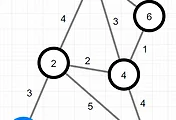우선순위 큐에 대하여 알아보고 힙 자료구조를 통하여
JS 코드로 어떻게 짜는지에 대하여 알아보자.
🧲 우선순위 큐란?
- 일반 FIFO인 큐와 다르게 우선순위가 높은 노드 먼저 나갈 수 있다.
- 최솟값이나 최댓값을 빠르게 찾아내기 위해 완전 이진 트리를 사용한다
🧲 구현
- 배열 및 연결리스트로 구현
간단히 구현이 가능한 장점이 있지만 데이터를 삭제 및 삽입해야할 경우 모든 인덱스를 탐색하는 과정이 있기 때문에 시간복잡도가 O(N)이 되므로 상대적으로 성능이 부족하다 - 힙으로 구현
구현이 어렵지만 enqueue, dequeue 시간 복잡도가 O(logN)이다
단순히 N개의 데이터를 힙에 넣었다가 모두 꺼내는 작업은 힙 정렬과 동일하며 이 경우엔 O(NlogN)이다.
🧲 구현 방법에 따른 시간 복잡도

🧲 힙이란
O(NlogN) 대표적으로 heap이 있다.
heap은 이진트리 형태로 데이터를 정렬하여 사용하는 자료구조로써,
수시로 변동되는 데이터에서, 최댓값, 최솟값을 빠르게 찾아주도록 도와주는 자료구조이다.
🧲 힙의 특징

- 완전 이진 트리 자료구조이다.
완전 이진 트리란 마지막 레벨을 제외하고 모든 레벨이 모두 채워져있으며, 마지막 레벨의 모든 노드는 왼쪽부터 오른쪽으로 차있다.
즉 루트 노드로부터 시작하여 왼쪽에서 오른쪽 자식 노드 순서대로 데이터가 순차적으로 삽입되는 트리를 의미한다. - 최소힙
루트 노드가 가장 작은 값을 가지며 값이 작은 데이터가 우선적으로 제거된다.
부모노드가 항상 자식노드보다 값이 작다. - 최대힙
루트 노드가 가장 큰 값을 가지며 값이 큰 데이터가 우선적으로 제거된다.
부모노드가 항상 자식노드보다 값이 크다. - 힙의 인덱스 관계
좌측 자식 노드의 인덱스 : (부모 노드의 인덱스 2 ) + 1
우측 자식 노드의 인덱스 : (부모 노드의 인덱스 2 ) + 2
부모 노드의 인덱스 : Math.floor( 자식노드의 인덱스 - 1 / 2 ) - 배열을 힙으로 구현하면 arr[0]이 최상단 부모이다
- N개의 데이터를 힙 구조로 만드는 복잡도는 O(NlogN)이다
🧲 Min Heap 구현하기
class MinHeap {
constructor() {
this.arr = [];
}
getLeftChildIndex = (currIndex) => currIndex * 2 + 1;
getRightChildIndex = (currIndex) => currIndex * 2 + 2;
getParentIndex = (currIndex) => Math.floor((currIndex-1) / 2);
}🧲 insert, heapifyUp
1. 배열의 끝에 넣는다
2. MinHeap형태를 갖출 수 있도록 heapifyUp를 통해 아래에서 위로 이동하며 새로 삽입한 노드의 제자리를 찾아준다.
Min Heap의 heapifyUp메서드
- 먼저 새로운 노드의 부모노드를 찾는다
- 부모와 새로운 노드의 값을 비교한다
- 만약 부모보다 새로운 노드가 작으면 이 둘을 swap한다
- 새로운 노드가 루트노드가 될때까지 3을 반복한다
class MinHeap {
// ....
insert(value) {
this.arr.push(value); // 배열 마지막에 새로운 값 추가
this.heapifyUp(this.arr.length - 1); // 아래에서 위로 힙 정리하기
}
heapifyUp(index) {
if (index) {
const parentIndex = this.getParentIndex(index);
// 부모값이 새로 삽입된 값보다 크면 부모의 자리를 아래로 내린다
if (this.arr[parentIndex] > this.arr[index]) {
const temp = this.arr[parentIndex];
this.arr[parentIndex] = this.arr[index];
this.arr[index] = temp;
this.heapifyUp(parentIndex);
}
}
}
}🧲 remove, heapifyDown
- 배열의 길이가 0이면 false를 리턴한다
- 길이가 1이상이면 최상위 노드를 제거하고 마지막 노드를 최상위 노드로 교체한다
- MinHeap형태를 갖출 수 있도록 heapifyDown를 통해 위에서 아래로 이동하며 2번에서 만든 새로운 최상위 노드의 제위치를 찾는다
Min Heap의 heapifyDown메서드
- 왼쪽, 오른쪽 자식 노드를 찾는다
- 왼쪽과 오른쪽 중 작은 노드를 최상위 노드와 비교한다.
- 최상위노드가 더 크면 이 둘을 swap한다.
- 왼쪽 자식이 노드가 없을 때까지 (= leaf노드) 1~3을 반복한다.
class MinHeap {
// ....
remove() {
if (this.arr.length === 0) {
return false;
}
const removed = this.arr[0];
this.arr[0] = this.arr.pop(); // 마지막 노드를 최상위노드로 올린다.
this.heapifyDown(0);
}
heapifyDown(index) {
// 왼쪽자식노드가 없으면 잎노드이므로 리턴
if (this.getLeftChildIndex(index) >= this.arr.length) {
return;
}
const leftChildIndex = this.getLeftChildIndex(index);
const rightChildIndex = this.getRightChildIndex(index);
// 왼쪽, 오른쪽 자식 중 더 작은 자식을 찾는다.
let smallerChildIndex = leftChildIndex;
// 오른쪽 자식이 더 작을시
if (this.arr[leftChildIndex] > this.arr[rightChildIndex]) {
smallerChildIndex = rightChildIndex;
}
if (this.arr[index] > this.arr[smallerChildIndex]) {
const temp = this.arr[index];
this.arr[index] = this.arr[smallerChildIndex];
this.arr[smallerChildIndex] = temp;
this.heapifyDown(smallerChildIndex);
}
}
}🧲 전체코드
class MinHeap {
constructor() {
this.arr = [];
}
getLeftChildIndex = (currIndex) => currIndex * 2 + 1;
getRightChildIndex = (currIndex) => currIndex * 2 + 2;
getParentIndex = (currIndex) => Math.floor((currIndex - 1) / 2);
insert(value) {
this.arr.push(value); // 배열 마지막에 새로운 값 추가
this.heapifyUp(this.arr.length - 1); // 아래에서 위로 힙 정리하기
}
heapifyUp(index) {
// 최상단이 아닌 경우
if (index > 0) {
const parentIndex = this.getParentIndex(index);
// 부모값이 새로 삽입된 값보다 크면 부모의 자리를 아래로 내린다
if (this.arr[parentIndex] > this.arr[index]) {
// swap
const temp = this.arr[parentIndex];
this.arr[parentIndex] = this.arr[index];
this.arr[index] = temp;
// 계속heapify
this.heapifyUp(parentIndex);
}
}
}
remove() {
if (this.arr.length === 0) {
return false;
}
const removed = this.arr[0];
this.arr[0] = this.arr.pop(); // 마지막 노드를 최상위노드로 올린다.
this.heapifyDown(0);
}
heapifyDown(index) {
// 왼쪽자식노드가 없으면 잎노드이므로 리턴
if (this.getLeftChildIndex(index) >= this.arr.length) {
return;
}
const leftChildIndex = this.getLeftChildIndex(index);
const rightChildIndex = this.getRightChildIndex(index);
// 왼쪽, 오른쪽 자식 중 더 작은 자식을 찾는다.
let smallerChildIndex = leftChildIndex;
// 오른쪽 자식이 더 작을시
if (this.arr[leftChildIndex] > this.arr[rightChildIndex]) {
smallerChildIndex = rightChildIndex;
}
if (this.arr[index] > this.arr[smallerChildIndex]) {
// swap
const temp = this.arr[index];
this.arr[index] = this.arr[smallerChildIndex];
this.arr[smallerChildIndex] = temp;
// 계속 heapifyup
this.heapifyDown(smallerChildIndex);
}
}
}
const heap = new MinHeap();
heap.insert(5);
heap.insert(3);
heap.insert(1);
heap.insert(4);
heap.insert(0);
console.log(heap.arr); // [ 0, 1, 3, 5, 4 ]
heap.remove();
console.log(heap.arr); // [ 1, 4, 3, 5 ]
'알고리즘' 카테고리의 다른 글
| [프로그래머스] 숫자 변환하기 (0) | 2023.12.06 |
|---|---|
| [프로그래머스] 코딩테스트 공부 (0) | 2023.11.25 |
| [카카오 2022] 등산코스 정하기 (0) | 2023.11.18 |
| [레벨2] n^2 배열 자르기 (0) | 2023.11.03 |
| [프로그래머스 LV2] 연속 부분 수열 합의 개수 JS (0) | 2023.11.03 |



